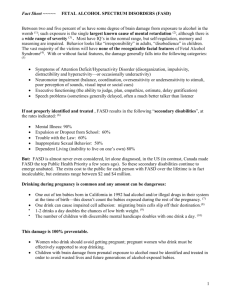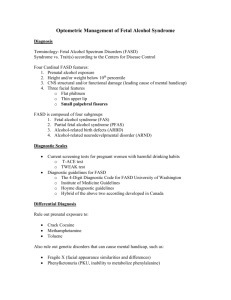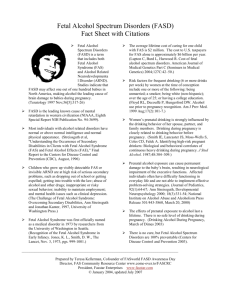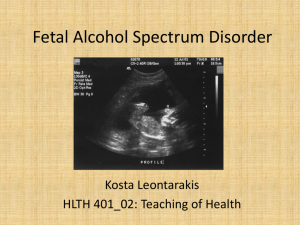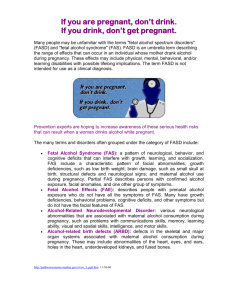Fetal Alcohol Syndrome
advertisement
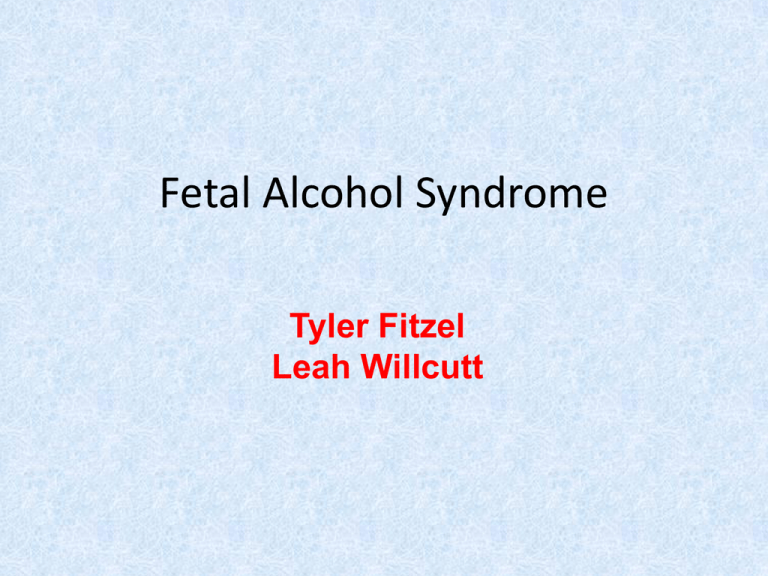
Fetal Alcohol Syndrome Tyler Fitzel Leah Willcutt Signs and Symptoms Physical Effects • • • • Characteristic facial features Small eyes (two standard deviations) Mental effects • Learning disabilities • Behavior problems • Hyperactivity • poor self control Narrow upper lip No ridges above lip and below nose • Physical deformities • vision difficulties • heart defects Causes • Caused by maternal consumption of alcohol during pregnancy • Exposure window and dosage very important! • Alcohol crosses the placenta • • Fetal BAC is higher than the mother due to slower metabolic rate All parts of the developing brain can be affected Mechanisms 1. Apoptosis: Alcohol triggers and facilitates cell death during development 2. Epigenetics: Alcohol exposure turns genes on or off • • Evidence shows the gene responsible for myelinating cells in white matter turned off by alcohol Changes can be passed down to offspring 3. Iron metabolism: Alcohol affects how iron is metabolized in the body • Iron deficiency during development shown to interfere with learning Treatments? • • Medications can treat the symptoms but not reverse the effects New experimental treatment is supplementing infant diet with choline, which has been shown to stimulate hippocampus development Impact on Student Learning • Attention • • Executive functions • • Difficulty with encoding, but not retrieval or retention of words Visual and spatial • • Difficulty with organization and planning Verbal learning • • Difficulty in shifting attention from one topic to the next Difficulty replacing objects to original position on a table. Reaction time • Slower eye movements in reacting to visual stimuli Ethics • Maternal vs. Fetal rights? The 1999 landmark US case of the State vs Deborah Z, a 34-year-old woman who had drunk heavily during pregnancy and immediately prelabour and delivered a child with FAS, highlights some of the legal and moral issues. Question: Is it ethical to charge Deborah Z with a crime for drinking during pregnancy? Answer Deborah Z was charged with attempted murder and reckless endangerment. Prosecution argued that a woman should be held accountable for injury caused to her unborn child by her actions. However, on the basis of a ruling that a fetus is not in law a human being, the Wisconsin Appeals Court concluded that such a mother could not be held criminally liable. Interesting Facts • • • • White, college-educated women most at risk for children with FASD Animals exposed to alcohol during gestation show a greater preference for alcohol during adulthood than unexposed animals Metabolism of alcohol different for every woman—identical twins have been reported where one affected, one not! Wisconsin has the highest number of incidences of FASD, Minnesota is #7 Sources • Mukherjee, R., Eastman, N., Turk, J., Hollins. S. Lancet. “Fetal Alcohol Syndrome: Law and Ethics”. • Mayo Clinic (www.mayoclinic.com) Symptoms and signs • Center for Disease Control and Prevention (www.cdc.gov) • (www.pubs.niaaa.nih.gov/publications/aaso.htm) Impact on learning • NIH Alcohol Alert No. 50 http://pubs.niaaa.nih.gov/publications/aa50.htm • • Olney, J. (2004), Fetal alcohol syndrome at the cellular level. Addiction Biology, 9: 137–149. Jeffrey R. Wozniak, Ph.D., L.P., Interview 6-29-2011

